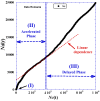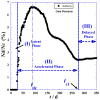Empirical Modeling of COVID-19 Evolution with High/Direct Impact on Public Health and Risk Assessment
- PMID: 35329394
- PMCID: PMC8948883
- DOI: 10.3390/ijerph19063707
Empirical Modeling of COVID-19 Evolution with High/Direct Impact on Public Health and Risk Assessment
Abstract
This report develops a conceivable mathematical model for the transmission and spread of COVID-19 in Romania. Understanding the early spread dynamics of the infection and evaluating the effectiveness of control measures in the first wave of infection is crucial for assessing and evaluating the potential for sustained transmission occurring in the second wave. The main aim of the study was to emphasize the impact of control measures and the rate of case detection in slowing the spread of the disease. Non pharmaceutical control interventions include government actions, public reactions, and other measures. The methodology consists of an empirical model, taking into consideration the generic framework of the Stockholm Environment Institute (SEI) Epidemic-Macroeconomic Model, and incorporates the effect of interventions through a multivalued parameter, a stepwise constant varying during different phases of the interventions designed to capture their impact on the model. The model is mathematically consistent and presents various simulation results using best-estimated parameter values. The model can be easily updated later in response to real-world alterations, for example, the easing of restrictions. We hope that our simulation results may guide local authorities to make timely, correct decisions for public health and risk assessment.
Keywords: COVID-19; Romania; accelerated spread; delayed spread; empirical modeling; mortality.
Conflict of interest statement
The authors have declared no conflict of interest.
Figures







Similar articles
-
Modeling COVID-19 spread using multi-agent simulation with small-world network approach.BMC Public Health. 2024 Mar 2;24(1):672. doi: 10.1186/s12889-024-18157-x. BMC Public Health. 2024. PMID: 38431581 Free PMC article.
-
Assessing the impact of adherence to Non-pharmaceutical interventions and indirect transmission on the dynamics of COVID-19: a mathematical modelling study.Math Biosci Eng. 2021 Oct 15;18(6):8905-8932. doi: 10.3934/mbe.2021439. Math Biosci Eng. 2021. PMID: 34814328
-
Modeling and analysis of COVID-19 based on a time delay dynamic model.Math Biosci Eng. 2020 Nov 24;18(1):154-165. doi: 10.3934/mbe.2021008. Math Biosci Eng. 2020. PMID: 33525085
-
In the interest of public safety: rapid response to the COVID-19 epidemic in Vietnam.BMJ Glob Health. 2021 Jan;6(1):e004100. doi: 10.1136/bmjgh-2020-004100. BMJ Glob Health. 2021. PMID: 33495284 Free PMC article. Review.
-
The Successes and Failures of the Initial COVID-19 Pandemic Response in Romania.Front Public Health. 2020 Jul 10;8:344. doi: 10.3389/fpubh.2020.00344. eCollection 2020. Front Public Health. 2020. PMID: 32766201 Free PMC article. Review.
Cited by
-
Mitigation Planning and Policies Informed by COVID-19 Modeling: A Framework and Case Study of the State of Hawaii.Int J Environ Res Public Health. 2022 May 18;19(10):6119. doi: 10.3390/ijerph19106119. Int J Environ Res Public Health. 2022. PMID: 35627656 Free PMC article. Review.
-
COVID-19 Pandemic Risk Assessment: Systematic Review.Risk Manag Healthc Policy. 2024 Apr 11;17:903-925. doi: 10.2147/RMHP.S444494. eCollection 2024. Risk Manag Healthc Policy. 2024. PMID: 38623576 Free PMC article. Review.
References
-
- Anderson R.M., Anderson B., May R.M. Infectious Diseases of Humans: Dynamics and Control. Oxford University Press; Oxford, UK: 1992.
Publication types
MeSH terms
Grants and funding
LinkOut - more resources
Full Text Sources
Medical

